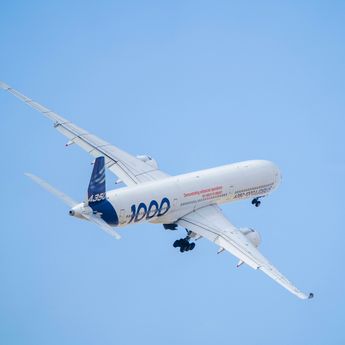Airbus Summit 2022

Gathering pace towards sustainable aerospace
AIRBUS SUMMIT 2022
The Airbus Summit 2022 brought together business leaders, partners, and industry experts to exchange ideas and debate the challenges and opportunities that are transforming our world. It showcased the best in international cooperation and built on the momentum of the event in 2021.
The aerospace industry is undergoing a period of rapid change, with advancements being made towards our sustainability commitments, and new technologies transforming the way we look at flight. But these positive steps are contrasted with an ever-complex external environment: war on Europe’s borders, economic instability, and an energy crisis that looks set to bite in winter.


Exploring the potential of the Moon
What’s next in Space
Why is it important that humans establish a sustained presence on the Moon? This is the key question that Airbus’ space exploration experts answered during this panel.
If we can learn how to live on the Moon that means we will have mastered a multitude of advanced technologies, from how to generate oxygen and energy to the creation of habitable structures on another celestial body.
Central to achieving this will be the partnerships between public agencies and commercial enterprises which are giving shape to the #NextSpace era.


Decarbonising now
The ecosystem perspective
This session explored the particular challenges that airlines and energy providers face when it comes to balancing decarbonisation with growth.
This panel explored how to make immediate progress on the decarbonisation of commercial aviation with a solution which is both available now and compatible with airlines’ individual growth ambitions and traffic demand: sustainable aviation fuel (SAF).
We provided insights into how key players in the sector currently use and provide SAF as well as other enablers. We also explained how Airbus is developing the SAF ecosystem of the future through its own operations and by working together with energy providers and airlines.


ZEROe unfiltered
Hydrogen-powered flight
The subtle art of powering an aircraft with hydrogen. A lot has happened since we unveiled our ZEROe concept aircraft.
We’ve been busy with partners around the world exploring disruptive technologies, setting up new ecosystems, and pushing ahead with our plans to bring a hydrogen-powered aircraft to market.
In this panel, we invited you to take a front-row seat for one of the most challenging – but also most exciting – projects our industry has ever undertaken: ZEROe, which aims to make hydrogen-powered flight a reality.


Let’s get hybrid
Aircraft performance
As we strive to reduce our environmental impact, hybridisation is one of the levers we can use to improve aircraft performance and reduce fuel consumption. Creating and deploying hybrid solutions relies on the entire ecosystem working together. Collaboration between players in the transport sector, engine manufacturers and partners will all contribute to the cleaner, hybrid future that we envisage.
During the summit we looked at how our partners use hybridisation and how we are working together with engine manufacturers and OEM to innovate and progress.


Towards clean vertical flight
Decarbonising helicopters
Decarbonisation of the helicopter industry is a priority not only for Airbus, but also for operators and lessors.
This panel explored the journey to decarbonising vertical lift and reflected on the steps required to deliver our ambitious net-zero emissions targets.
We also heard from some of our customers on why this is important for them and their operations, the challenges they face, and what they expect from manufacturers.


Together towards net zero
A collective challenge
Following the 41st ICAO Assembly in October 2022, industry and governments are now aligned on the long-term aspirational goal to achieve net-zero carbon emissions by 2050.
The focus now turns to concrete action. The private and public sector need to come together with renewed commitment to agree how to turn this ambition into reality.
This session debated the next steps and challenged the industry’s progress, whilst taking into account the complex external environment.


Building a stronger Europe
Defence, security and sustainability. Global climate and energy transition targets are ambitious. In order to have the best chance of achieving them, our societies need to be resilient, peaceful and stable.
This panel brought together policymakers, industry leaders and think tankers to discuss the need for robust European defence and security – and why this is a prerequisite if we hope to achieve our sustainability targets.


UAM can be a lifesaver
Serving society
Urban Air Mobility (UAM) has the potential to transform our cities and the way we live. A particularly exciting opportunity exists in how it can support key partners in critical missions, saving lives and helping medical services to reach the people who need them.
This panel explored the role of UAM in improving healthcare ecosystems whilst also supporting decarbonisation ambitions.
Latest news in innovation and sustainability
In the spotlight
-

Airbus and partners complete successful wake energy retrieval trials
Press Release
Innovation
Airbus and partners complete successful wake energy retrieval trials -

How Book and Claim enables SAF use for HEMS operations
Web Story
Helicopters
-

Airbus fosters Barry Callebaut`s efforts to develop a deforestation-free supply chain
Press Release
Sustainability
-

Showcasing multiple decarbonisation levers at Dubai Airshow
Web Story
Sustainability
-

Combating information warfare: How Airbus is helping win the fight for the truth
Web Story
Defence

